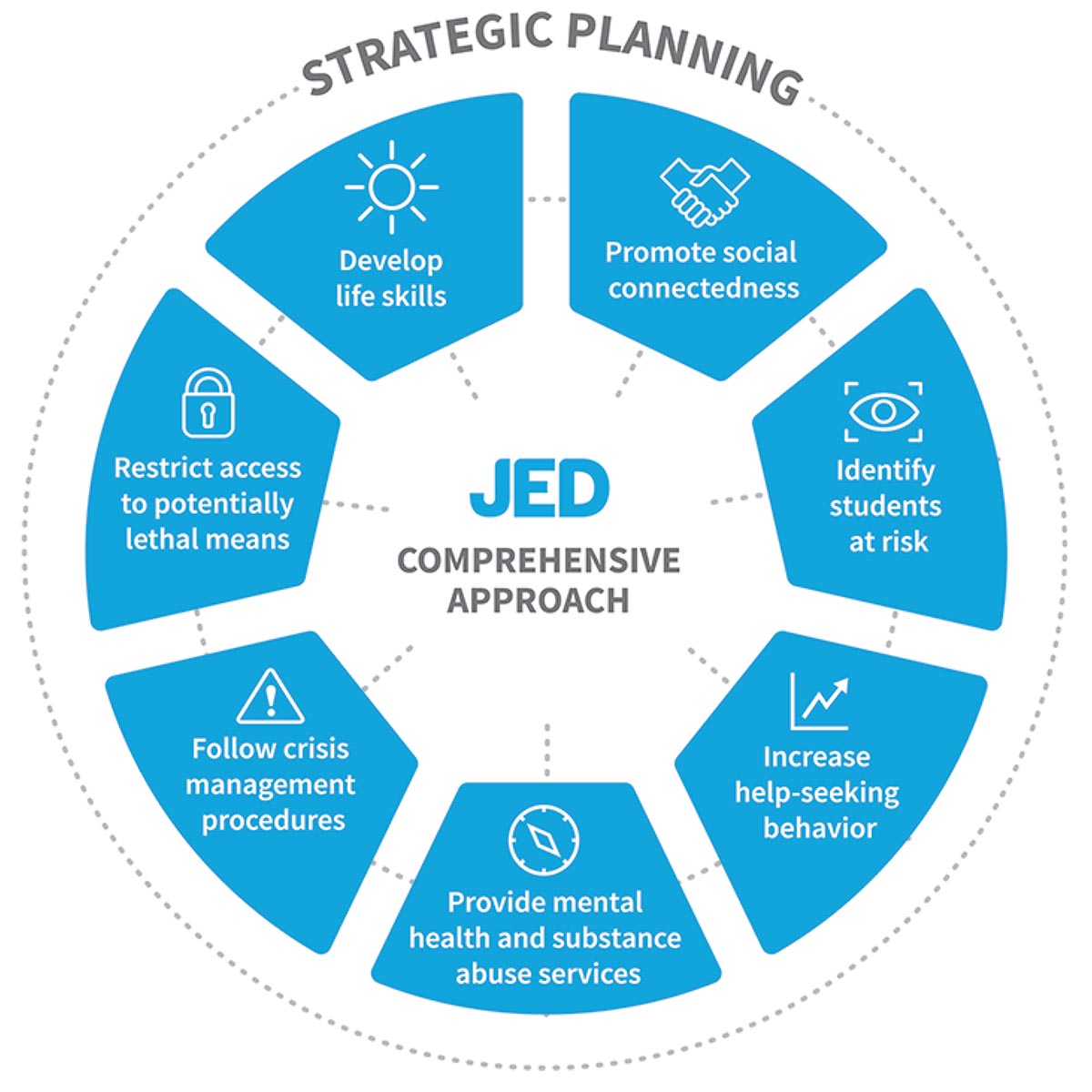JED Campus

- By becoming a member of the JED Campus program, a school demonstrates a commitment to the emotional well-being of its students. JED Campus schools embark on a multi-year strategic collaboration that not only assesses and enhances the work that is already being done but helps create positive, lasting, systemic change in the campus community.
- JED Campus is an initiative of The Jed Foundation, a national nonprofit that exists to protect the emotional health of our country’s 40 million high school and college students and reduce the risks of substance abuse and suicide. To learn more visit jedcampus.org.
- JED Committee
- Lisa Joyner: Vice President for Student Success and Student Life
- Toi Durham: Director, Bachelor of Science in Nursing
- Naomi Berger-Perez: Director of Counseling Services
- Judith Quander: Associate Vice President, Faculty Affairs and Faculty Development
- Erica Morales: Interim Vice President, Human Resources
- JED Approach

-
- Strategic Planning
- Strategic planning allows schools to anticipate and evaluate clinical and programming needs, examine how they deploy both personnel and financial resources to address challenges, coordinate efforts across campus, and evaluate programming effectiveness.
- Objective: Ensure that emotional well-being is a campus wide responsibility.
- Develop and Support Life Skills
- Supporting life skills education is valuable in teaching healthy ways to cope with the stress of college life. Some of the life skills that are important to a student's well-being include managing friendships and relationships, problem-solving, decision making, identifying and managing emotions, healthy living, and finding the purpose, meaning and identity.
- Objective: Teach students the skills necessary to cope with the stresses of college life, make wise lifestyle choices, and be academically successful.
- Promote Social Connectedness
- Research has shown that loneliness and isolation are significant risk factors for mental health problems and/or suicidal behavior. Therefore, supportive social relationships and feeling connected to campus, family and friends are protective factors that can help lower risk.
- Objective: Implement sustainable programs that offer students the opportunity to build connections with others in their community.
- Identify Students at Risk
- It is important to take action to identify students at risk for mental health problems and/or suicidal behavior, and also to promote emotional health awareness among those who interact with students the most - "gatekeepers" such as academic advisers, faculty and even fellow students - as it is vital for these people to be able to recognize and refer a student who might be in distress.
- Objective: Ensure incoming students with mental health and substance abuse histories are supported in their transition to college.
- Increase help seeking behavior
- Many students who need help may be reluctant or unsure of how to seek it out. Obstacles to help-seeking include lack of awareness of mental health services, skepticism about the effectiveness of treatment, prejudices associated-with mental illness, and uncertainty about costs or insurance coverage. Campuses should engage in a variety of activities designed to increase the likelihood that a student in need will seek help.
- Objective: Promote help seeking behavior through destigmitization efforts and increased access to resource information.
- Provide mental health and substance abuse services
- It is essential to offer accessible, consistent and high-quality mental health services to students. To make mental health and substance abuse care more comprehensive, it should include strong and flexible services, adequate staffing levels, flexibility in treatment approaches, and clinic hours that are reflective of student schedules. Since most college clinics are free, the length of treatment is often limited. Therefore, it is important that campus mental health services can assist students in finding off-campus resources that can provide long-term care if needed.
- Objective: Ensure students have adequate and comprehensive health insurance coverage.
- Follow Crisis Management Procedure
- The campus should have access to a well-publicized 24/7 crisis phone and/or chat line either through campus resources or local/national services. There should be a process in place to share information (as legally appropriate) between local ERs and school health and/or counseling services.
- Objective: Ensure an adequate and appropriate institutional response to student suicide, death, or other emergency.
- Restrict Access to Potentially Lethal Means
- It has been well established that if the means to self-harm are removed or limited in an environment, it can prevent suicide and even limit accidental deaths. This is called "means restriction. " Limiting students' access to weapons, poisonous chemicals and rooftops, windows or other high places are all means restriction activities. Each campus should do an environmental scan for potential access to lethal or dangerous means.
- Objective: Proactively minimize environmental risks for suicide.
- Strategic Planning
